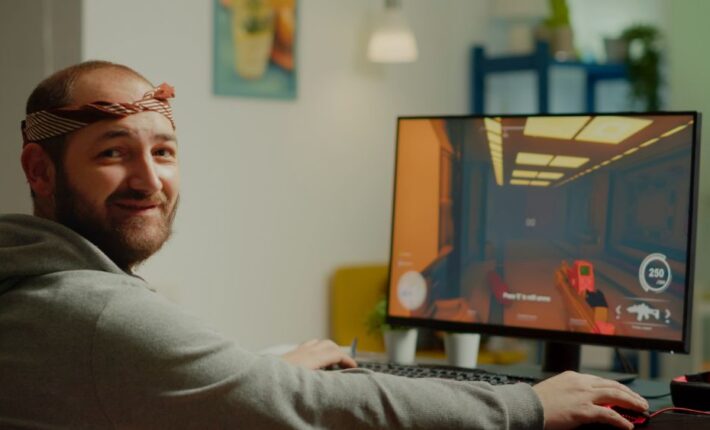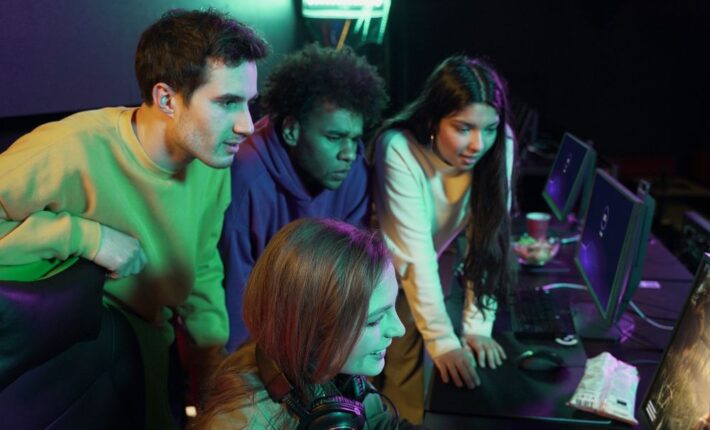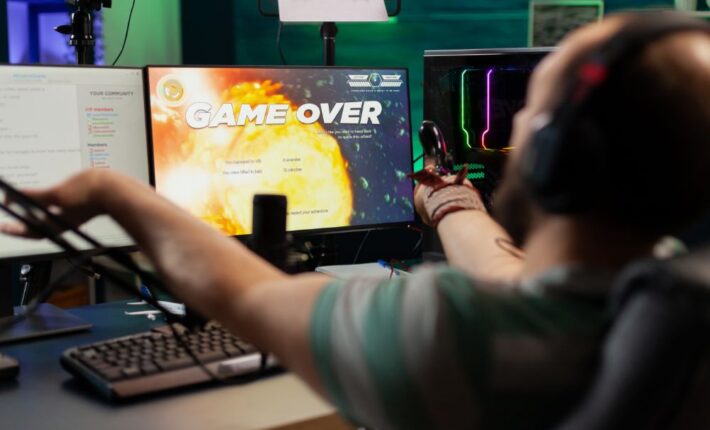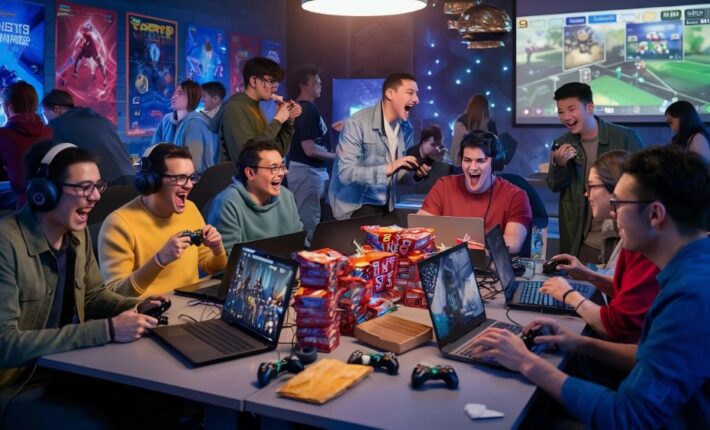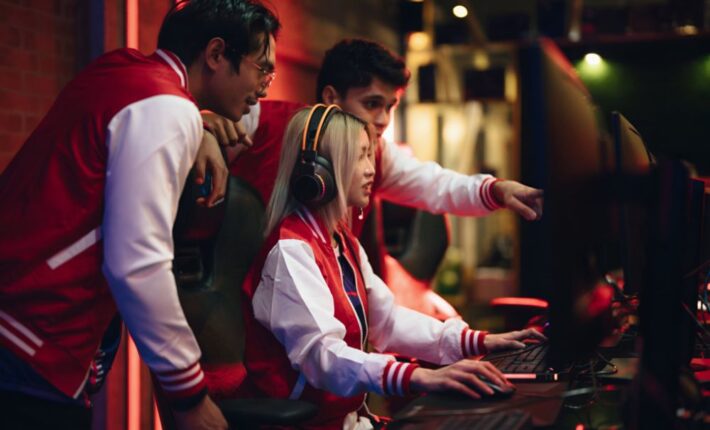When training for competitive gaming, a structured approach is essential. This includes optimizing practice sessions and developing mental resilience. Simply playing endlessly is insufficient for improvement; setting clear goals and analyzing gameplay are crucial steps.
Additionally, physical fitness and mindfulness exercises are important components of a comprehensive training regimen. Balancing these aspects requires strategic planning and disciplined execution.
This text explores strategies to help you excel in the competitive gaming arena, focusing on evidence-based practices and practical steps.
Key Takeaways
- Set clear, achievable goals and break down practice sessions into specific skill segments.
- Develop mental resilience with mindfulness exercises and stress management techniques.
- Establish regular team practice sessions to improve communication and synergy.
- Analyze gameplay recordings to identify mistakes and areas for improvement.
- Stay updated with meta changes and adapt strategies accordingly.
Optimizing Practice Sessions
Optimizing practice sessions is crucial for individuals aiming to excel in competitive gaming. A structured approach is necessary to make the most efficient use of time. Begin by setting clear and achievable goals for each session. Rather than playing for extended periods without direction, focus on specific skills such as aiming, strategy, or communication.
It is advisable to divide practice into manageable segments. Several concentrated sessions are more effective than one prolonged session, which can lead to exhaustion. Incorporating short breaks can help maintain concentration and prevent burnout.
Reviewing gameplay is a vital component of effective practice. Recording sessions allows for the analysis of mistakes and the identification of areas needing improvement. Watching replays critically can help understand errors and develop strategies to address them in future sessions.
Practicing with a team can also enhance performance. Real-time coordination with teammates improves communication skills and helps in understanding various play styles.
It’s important to discuss strategies and provide constructive feedback to each other.
Enhancing Mental Resilience
Enhancing mental resilience is crucial for managing the pressures of competitive gaming. To achieve this, it’s beneficial to develop a consistent routine that includes mindfulness exercises, such as meditation or deep-breathing techniques. These practices can help maintain calmness under pressure and improve focus during intense matches.
Adopting a positive mindset by reframing negative thoughts is also essential. Instead of focusing on mistakes, viewing them as opportunities for learning can significantly enhance overall performance and facilitate quicker recovery from setbacks.
Setting realistic goals is another important strategy. Breaking down long-term objectives into smaller, manageable tasks makes goals more attainable and provides a sense of accomplishment throughout the process.
Physical health plays a significant role in boosting mental resilience. Regular exercise, a balanced diet, and sufficient sleep can enhance cognitive functions and emotional stability, thereby contributing to better mental resilience.
Analyzing Game Strategies
Mastering the analysis of game strategies is crucial for gaining a competitive edge in gaming. To begin, it’s important to study top players and high-level matches. Watching replays, taking notes, and identifying key moments where decisions led to victory or defeat can help in understanding effective strategies and their rationale.
Next, it’s beneficial to break down the game into its core components: objectives, character roles, and map control. Understanding these elements can assist in creating a mental framework for decision-making. Observing how top players position themselves, manage resources, and coordinate actions can enhance your understanding of in-game priorities.
Analyzing your own gameplay is also essential. Recording and reviewing your matches critically can help identify patterns in mistakes and successes. For example, consistently being outmaneuvered or missing opportunities to exploit opponent weaknesses can highlight areas for targeted improvement.
Additionally, staying updated with meta shifts and patch notes is important as games evolve. Keeping up-to-date ensures that strategies remain effective.
Engaging with the gaming community through forums and social media can facilitate discussions on tactics and the sharing of insights. This continuous learning process is fundamental to maintaining a competitive advantage.
Building Team Coordination
Effective team coordination is essential for success in competitive gaming. Without proper coordination, even highly skilled individual players may struggle.
First, it’s important to establish clear communication channels. Utilize voice chat tools and create a structured system for in-game communication. Team members should be aware of when to speak and what specific information to relay, ensuring that messages are clear and comprehensible.
Regular practice as a team is crucial. Playing together frequently allows team members to understand each other’s playstyles better. Scheduling consistent practice sessions helps in building synergy and trust. These sessions should focus on executing strategies and adapting to various scenarios that may arise during actual gameplay.
Assigning specific roles to each team member is also important. Each player should be clear about their responsibilities, whether it involves leading, supporting teammates, or executing strategic plays. This role clarity facilitates quick decision-making during critical moments in the game.
Reviewing games together can provide valuable insights. Watching replays helps in identifying mistakes and areas requiring improvement. Team discussions about what went well and what needs adjustment can foster constructive criticism, contributing to individual and team growth.
Lastly, fostering a positive team environment is beneficial. Encouragement and mutual support among team members can enhance overall performance. A team that communicates and collaborates effectively is more likely to achieve success in competitive gaming.
Also, I recommend reading our article The Importance of Team Dynamics in Esports
Physical Fitness for Gamers
Maintaining physical fitness can significantly enhance performance in competitive gaming. Although gaming isn’t traditionally viewed as physically demanding, staying fit can improve reflexes, focus, and overall endurance.
Regular cardiovascular exercises such as running or cycling can boost stamina and help maintain mental sharpness during extended gaming sessions. It’s advisable to engage in at least 30 minutes of cardio three to five times per week.
Strength training is also important. Exercises targeting the core and upper body can help maintain good posture, potentially reducing the risk of back and neck pain. Effective exercises include planks, push-ups, and dumbbell routines.
Flexibility shouldn’t be overlooked. Regular stretching can prevent muscle stiffness and improve the range of motion. Daily stretching routines that focus on the wrists, shoulders, and back are recommended.
Hydration and proper nutrition are crucial as well. Consuming sufficient water and balanced meals that include fruits, vegetables, and lean proteins is beneficial.
It’s advisable to limit the intake of caffeine and junk food, as they can lead to energy fluctuations.
Staying Updated With Meta
To stay competitive, you’ve got to keep up with patch notes and understand how they impact gameplay.
Watch pro players and analyze their strategies to see what’s working at the highest levels.
Incorporating these insights will help you adapt and excel in the ever-changing meta.
Follow Patch Notes
Keeping up with patch notes is essential for any competitive gamer looking to maintain a competitive edge. Patch notes detail the changes developers make to the game, which can significantly impact gameplay, strategies, and the overall meta. By carefully reading and understanding these updates, players can stay informed about what’s been adjusted, enhanced, or weakened, allowing them to adapt their playstyle as necessary.
Upon the release of a new patch, it’s advisable to read the notes promptly. Pay attention to any modifications to your main characters, weapons, or maps. These changes can influence your performance, so being aware of them is crucial. For example, if there’s a reduction in the damage output of a preferred weapon, you might need to alter your strategy or consider using an alternative.
Furthermore, patch notes frequently include bug fixes and new features. Familiarizing yourself with these can help prevent unexpected issues during matches. Engaging with forums, social media, and community discussions can also be beneficial, as other players may identify subtleties you might’ve missed.
This interaction can provide a more comprehensive understanding and offer different perspectives on the updates.
Analyze Pro Strategies
Professional gamers continuously explore the limits of competitive gaming, making it important to analyze their strategies to maintain a competitive edge.
Begin by observing recent tournaments and streams of top players. Focus on their decision-making processes, movement patterns, and how they adapt to various scenarios. This observation will aid in understanding the current meta and identifying trends that could potentially be advantageous.
Subsequently, deconstruct their gameplay by reviewing replays. Utilize tools such as slow-motion and frame-by-frame analysis to scrutinize their actions. Identify consistent patterns in their playstyle, including preferred weapons, positioning, and timing. Document what’s effective and what’s not, and consider how to integrate these tactics into your own gameplay.
Additionally, engage with the gaming community. Participate in forums, Discord servers, and social media groups focused on your game. Discussing professional strategies with other players can provide new insights and keep you informed about any changes in the meta.
Conclusion
To excel in competitive gaming, you’ve got to optimize your practice sessions, enhance your mental resilience, and analyze game strategies. Building team coordination and maintaining physical fitness are essential. Don’t forget to stay updated with the evolving meta by engaging with the gaming community and studying top players. Consistent practice and mindfulness exercises will help you manage stress and sharpen your skills. Keep pushing yourself, and you’ll be well on your way to success.




